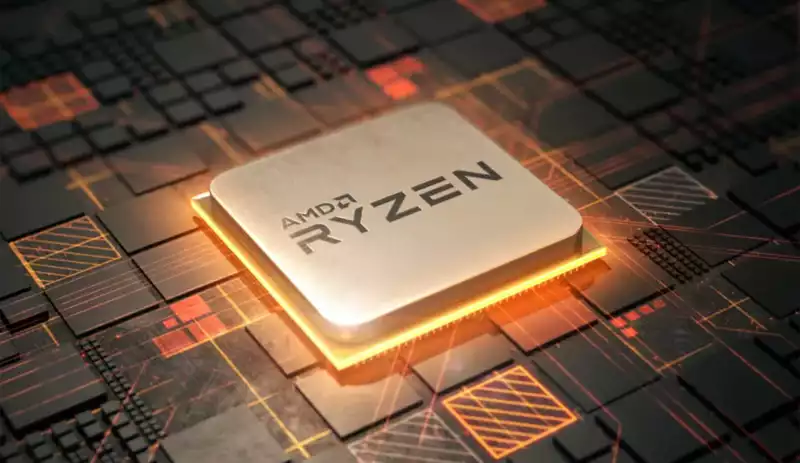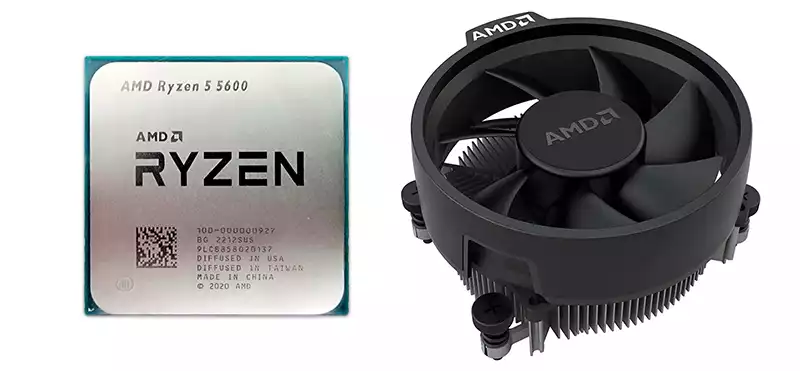You can also be interested in these:
The competition is very tough for AMD after the launch of the Alder Lake technology by its direct competition Intel. This has made them begin the research of new technologies to be able to face them in the CPU field, which has resulted, among other projects, in the AMD Ryzen 5 5600, a mid-range processor that promises to be an excellent contender.
The Ryzen 5600 is presented with an architecture similar to the 5600X. Although the performance is practically the same, this time the price compensates the deal and goes more in line to what it can offer.

A cheap mid-range processor
AMD knows that Intel’s Alder Lake processors are a real threat for the brand. The company has dedicated serious efforts in covering all those gaps Intel hasn’t thought of yet, like the needs of the mid-range market. We are not saying this is an audience completely forgotten by Intel, but it definitely can be improved.
On the other hand, the AMD’s high-end target never ceased to be impressed on its delivery. They got all the power they can possibly offer with the 5800X3D and innovative 3D V-Cache, eclipsing even Intel’s newest CPU technology, the 12900K.
But we are getting derailed a bit with the topic. The purpose of this article is to portrait the new CPU technologies that are being created by AMD as a consequence of filling Intel’s market gap in the mid-range field. In this process 3 amazing technologies were born:
- AMD Ryzen 5 5500: It is a cheap processor, and when we say cheap we do not mean that it is a low quality one. For its price and performance compared to the Intel’s i5-12400, it can offer incredible results. It has about 6 cores and processing capacity for 12 threads. Its architecture is Cezanne, although it has no internal GPU.
- AMD Ryzen 5 5600: The flagship processor at the moment is the Ryzen 5 5600, which has a performance similar to the 5600X, but with a price adjustment that makes it worthy of this study. His node is Vermeer accompanied by a CCX I.F.
- AMD Ryzen 7 5700X: A somewhat more powerful model since it has 16 threads and about 8 cores. It is the Vermeer-type just like the previous one. Again, AMD is trying to compete with price as a spearhead. The AMD Ryzen 7 5700X is the way to go.
As for the Ryzen 5 5600, it has an AM4 PGA 1331 type processor, which includes two chiplets with gold-plated contacts. The internal heat sink is made of copper mixed with aluminum, making it an excellent conductor of heat. The heatsink is strongly attached to the cores, so it will not be possible to separate it.
Heatsink included in the package
This processor is sold with a Wraith Stealth type heatsink, something already seen in the AMD 65W CPUs. However, what is a great novelty is that the heatsink is fairly small. It is a little more powerful than those included by default on Athlon processors, but much less powerful when compared to Prism processors.
The middle area where the blades are jointed is hollow. It is a heatsink made entirely of aluminum about 20 x 90 mm thick and radius respectively. It has a total of 5 blades and a channel to carry hot air away from the processor area.

As far as its cooling capacity is about, the does the job of cooling the Ryzen 5 5600 very well, but this as long as it is not overclocked. The bad thing is that it can be a bit noisy when the CPU is working at its maximum. We recommend opting for another heatsink that fulfills the job with a little more cooling tasks oriented, both when overclocking and when not. A perfect example of a heatsink for this CPU would be a NZXT Kraken 240mm RL AIO.
Technical specs and architecture of the AMD Ryzen 5 5600
The architecture on this processor is the same we have seen in all the Ryzen 5000 line CPUs. It is optimized for gaming using 7nm TSMC Vermeer technology.
The architecture used in this model makes it impossible to place more than one CCD chiplet, which becomes a CCX thanks to the unification of Zen 2 and later technologies. It has 8 cores, however, only 6 of them are called active cores themselves. They have 12 processing threads, which makes it practically the same as other 5700X or even 5800X type processors, at least in its architecture. Of course, the frequency changes, since the 5600 can reach a maximum of 4.4 Ghz and a standard of 3.5 Ghz (remember that the 5600X reaches 4.6 Ghz by overclocking).
However, there would be no problem bringing the 5600 to the same numbers via overclock. If you are an expert on the subject, you will be able to achieve this and even more, since it has unlocked cores for the most curious and adventurous users for overclocking. The cache memory of the Ryzen 5 5600 is type L3 with 32 MB and L2 with 3 MB (divided between all the cores). The L1 type cache includes 32 KB per core.
Regarding the unit capacity of the cores, there are practically no notable differences between the 5600X and the 5600, since it is barely 200 Mhz, however, there are core-by-core differences. Now, in the field of temperature, the 5600 has its limitations, starting with its 65W heatsink, which sets its limit at 90 Cº.
As an additional chiplet, the input and output section is included where the PCIe-type lanes and memory controllers are located. It was manufactured under the Global Foundries standard, this being the traditional 12nm and the PCIe port being North Bridge, the latter 24 of type 4.0 are included, 20 being available for expansion and another 4 to communicate with the South Bridge.
This processor is compatible with up to 128 GB of RAM, which can be distributed in two slots for this type of memory. It natively supports 3200 Mhz for these memories. As in other 8-core processors, the Ryzen 5 5600 includes an Infinity Fabric bus where there are 32 bits for each read cycle and about 16 bits for a write cycle, which is not very good news since the performance of the RAM could drop by half.
Temperature and power consumption
One of the points that made us most curious about AMD’s Ryzen 5 5600 was overheating. A test was done by changing the factory heatsink for a 240 mm liquid-cooled one. We measured consumption and temperature at average levels for this great processor.

Without making any type of modification, this processor consumes a considerable amount of energy and overheats significantly without performing tasks, however, when basic tasks were loaded, its values regarding temperature were similar to those in the Ryzen 5 5500, even similar to those in the 12400 of Intel.
The results were 76W for the CPU under basic tasks and about 26W when leaving the PC idle. Although these are relatively high values, we were able to overclock and the results became 38W for the CPU at idle, 90W under basic tasks and 106W under stress.
We believe that the default heatsink does its job, however, when overclocking and putting the processor under some continuous stress, another cooling system will be necessary, such as the 240 liquid cooling system that we installed. In any case, about 90 Cº is an astronomical figure in terms of temperature. For the processor to reach it, it would have to spend several minutes with a 100% process load.
Conclusions about the Ryzen 5 5600 Do we recommend it?
Surely you ask yourself the same question that we asked ourselves at the time of finishing this analysis. Is it really worth considering the 5600 when the 5600X already exists? The answer is simple, it depends. If you already have a 5600X, it makes no sense to buy a 5600 since the performance of both is very similar, even in high-demand games.
The only barely noticeable difference is the 200 Mhz extra included in the 5600X, which is not a reason to say that this model with the “X” is superior. Normally both processors have a price that has around $20 USD difference between them.
But now for the good part, is it advisable to buy an AMD Ryzen 5 5600 or 5600X instead of an Intel 12400? To this question we must say no. Intel processors that include Alder Lake technology and only 6 cores outperform these in the gaming field, although those from AMD have come very close to these. However, it is valid to remember that the new Intel processors are not very cheap, and with AMD you may get a motherboard at a better price.
The AMD Ryzen 5 5600 has an introductory price of around $250 USD, which is higher than Intel’s i5 12400, but lower than the 12500 which has an average value of $260 USD. Because there is no significant difference in price, the 5600X would be a good option to choose, but if there is no stock of it (which is to expect), it does not matter to buy a 5600 since the performance will be the same.
